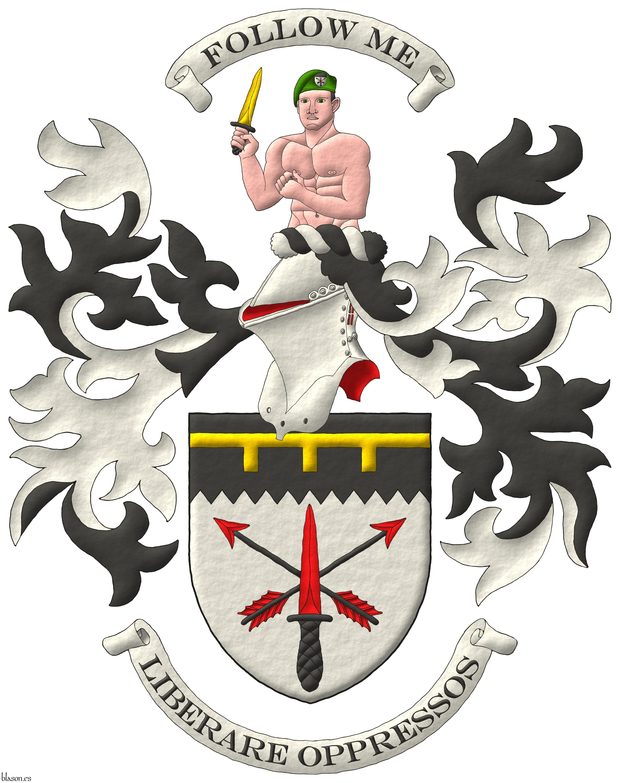Pommelled


Navarre
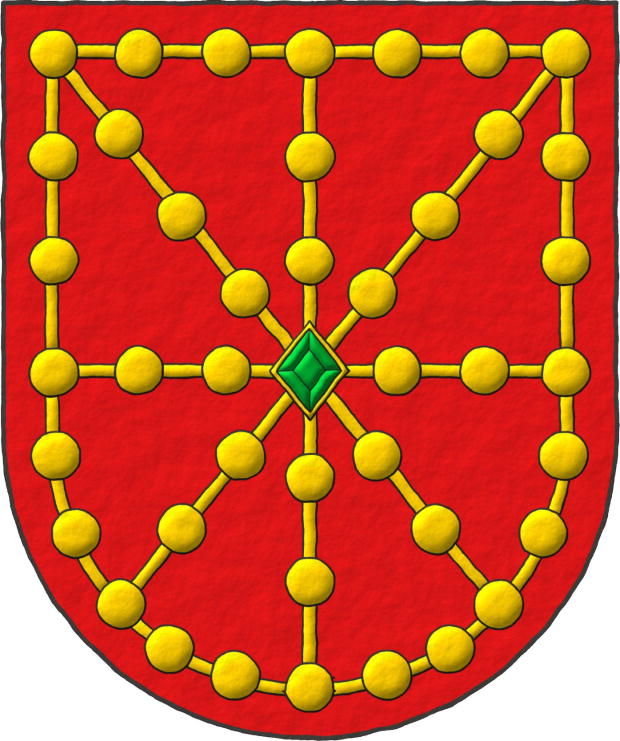
Escudo de gules, un carbunclo cerrado, pomelado de oro; cargado en el centro de una esmeralda en forma de losange de sinople.
Original coat of arms of Navarre interpreted with: a semicircular (round) base; the field in flat Gules; the pommetty carbuncle illuminated in Or and outlined in Sable; the emerald illuminated in Vert and also outlined in Sable; and the whole finished with a raised-stroke effect.
In the armorial [Urfé; Siglo XV; indexed on folio 151, but actually written on 142] the arms of Navarre are blazoned in French as «de gueles à l'escarboucle d'or pommelée alumée de sinoble en la moyenne en guise d'esmeraude», it only gives the blazon, since this armorial is not illustrated.
An image of the original French blazon text can be seen in the article Blazon of Navarre in the Urfé armorial.
The interpretation of the arms of Navarre shown here is based on the one illustrated in the armorial [Bosque, J. del; 1540; folio 1 of the 1613 numbering], which is its main plate, with the arms of the king of Navarre surrounded by the coats of arms of the lineages and manors of his «ricoshombres», twelve lineages in total.
In [Menéndez Pidal de Navascués, F.; 1963] one can consult his view on what is, probably, the real origin of the arms of Navarre, which he bases on:
- The existence of a defensive element of the shield called the boss, placed at its center. This element already existed in classical Rome, on the shields of the legionaries and, in addition, it could serve to keep small valuables inside.
- The later reinforcement of this boss with 8 spokes, that is, 4 diameters set vertically, horizontally, bendwise and bendwise sinister, giving rise to a radiated boss to strengthen the shield.
- This radiated boss on rich shields could be very elaborate and even be adorned with gems, thus becoming an ornamental element.
- The evolution of the radiated boss from a defensive and ornamental element to the so-called carbuncle, but now as a heraldic element with a radial structure. Originally the carbuncle was a mystical stone, comparable to the ruby, that emitted an intense light capable of illuminating the knight in the darkness of night. Heraldically the name carbuncle is used to denote a scheme of radial rays and not the marvellous stone that emitted them and from which it borrows its name.
- This eight-rayed carbuncle, joined at the ends forming a closure, like an orle, and decorated with pommels, on a field Gules, and with an emerald overall at its center is what constitutes the arms of Navarre.
Regarding the importance of the radiated boss and the carbuncle, not only in the arms of Navarre but in heraldry in general, [Menéndez Pidal de Navascués, F.; 1963] goes a step further when he writes «although it has never been pointed out, it seems evident to us the influence of this piece on the classic partitions of the shield, contained in the four diametral lines that compose it». He makes us see that «cortado, partido, tronchado y tajado» and, therefore also, «cuartelado, en sotuer y jironado», do not have their origin in the different ways of striking a shield with a sword, as illustrated, for example, in [Avilés, J.; 1725a; plate 18, illustrations 23, 24, 25 and 25], but in different ways of selecting, as delimiters, the four diameters of the carbuncle.
Blazon keywords: Without divisions, Gules, One, Carbuncle, Pommelled, Or, Charged, In the fess point, Emerald, Vert and Lozenge.
Style keywords: Freehand, Illuminated and Outlined in sable.
Classification: Interpreted, Civic and Coat of arms.
Bearer: Navarre.


Navarra, closed carbuncle
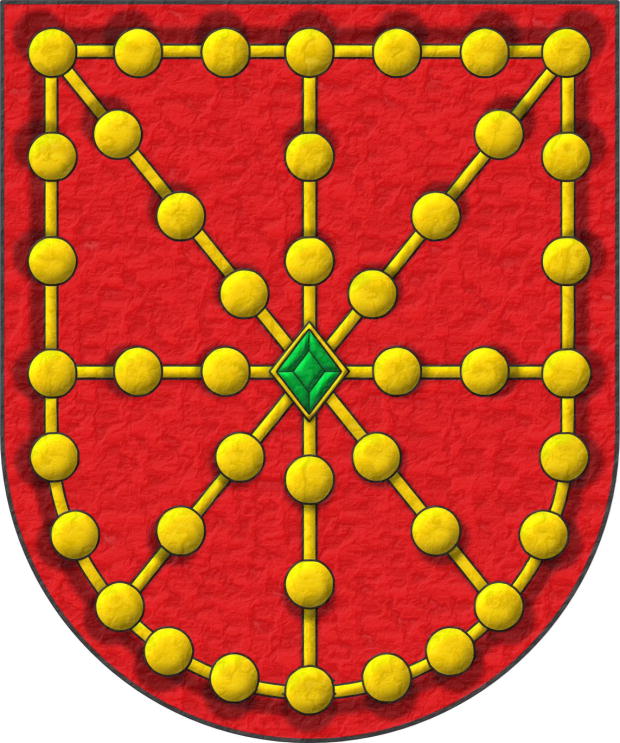
Escudo de gules, un carbunclo cerrado, pomelado de oro; cargado en el centro de una esmeralda en forma de losange de sinople.
Coat of arms interpreted with: a semicircular (round) base; the field in flat Gules; the pommetty carbuncle and the emerald illuminated in Or and Vert, shaded and outlined in Sable; and the whole finished in lightly-hammered metal.
In addition to historical documents such as the armorials [Urfé; 15th century] which blazons it and [Bosque, J. del; 1540] which illustrates it, there is, in the last half century, an abundant bibliography on the arms of Navarre, for example: [Menéndez Pidal de Navascués, F.; 1963], [Menéndez Pidal de Navascués, F.; 1974], [Martinena Ruiz, J. J.; 1982], [Menéndez Pidal de Navascués, F.; 1999], [Menéndez Pidal de Navascués, F.; Martínez de Aguirre, J.; 2000], [Martinena Ruiz, J. J.; Menéndez Pidal de Navascués, F.; 2001] and [Martínez de Aguirre, J.; 2007].
This pommetty shield can also be seen, for example, on the outer façade of the convent of Santo Domingo in Estella, on capitals preserved in the Cathedral of Tudela and on capitals of the church of Santa María la Real of Laguardia, the latter dating from the 14th century.
Blazon keywords: Without divisions, Gules, One, Carbuncle, Pommelled, Or, Charged, In the fess point, Emerald, Vert and Lozenge.
Style keywords: Soft metal, Illuminated, Outlined in sable and Shaded.
Classification: Interpreted, Civic and Coat of arms.
Bearer: Navarre.


Blasón de Navarra en el armorial Urfé
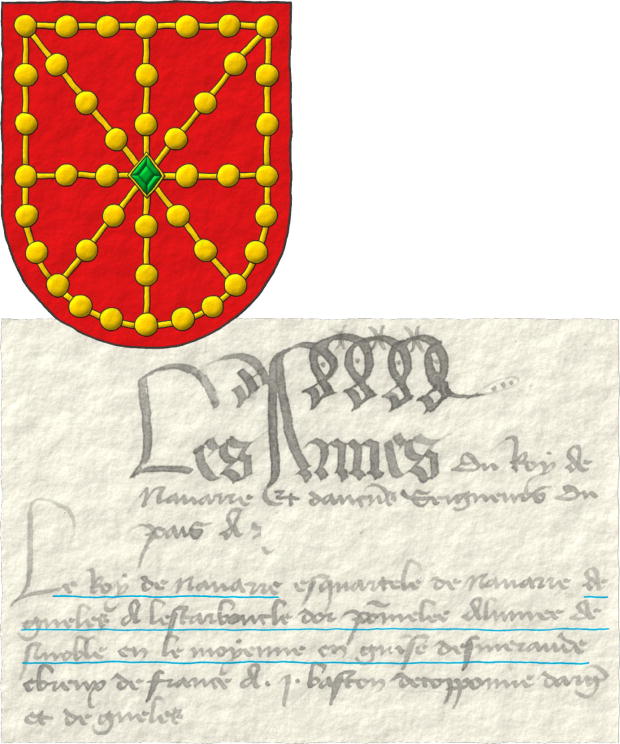
Escudo de gules, un carbunclo cerrado, pomelado de oro; cargado en el centro de una esmeralda en forma de losange de sinople.
The armorial [Urfé; 15th century] contains only blazons written in French and is not decorated with shields.
The image shows my interpretation of the arms and, beneath it, the blazon of the king of Navarre as follows «Le Roy de Navarre... de gueles à l'escarboucle d'or pommelée alumée de sinoble en la moyenne en guise d'esmeraude» which could be translated as «The King of Navarre... Gules, a carbuncle Or pommetty, illuminated Vert in the middle in the manner of an emerald».
Note that the blazon does not suggest the presence of an emerald, but that the place corresponding to the central boss of the shield, from which the rays of the carbuncle emerge, is enamelled Vert.
In the article Universitas Studiorum Navarrensis about the arms of the University of Navarre I interpret the arms of Navarre borne in profile by the Archangel Saint Michael, which, by my way of painting it, lies halfway between the carbuncle and the chains, with round chain links and long carbuncle rays, where at the centre there is no emerald, but a Vert enamel in the manner of an emerald.
Blazon keywords: Without divisions, Gules, One, Carbuncle, Pommelled, Or, Charged, In the fess point, Emerald, Vert and Lozenge.
Style keywords: Soft metal, Illuminated, Outlined in sable and Shaded.
Classification: Interpreted, Civic and Coat of arms.
Bearer: Navarre.


Guy Harold Power
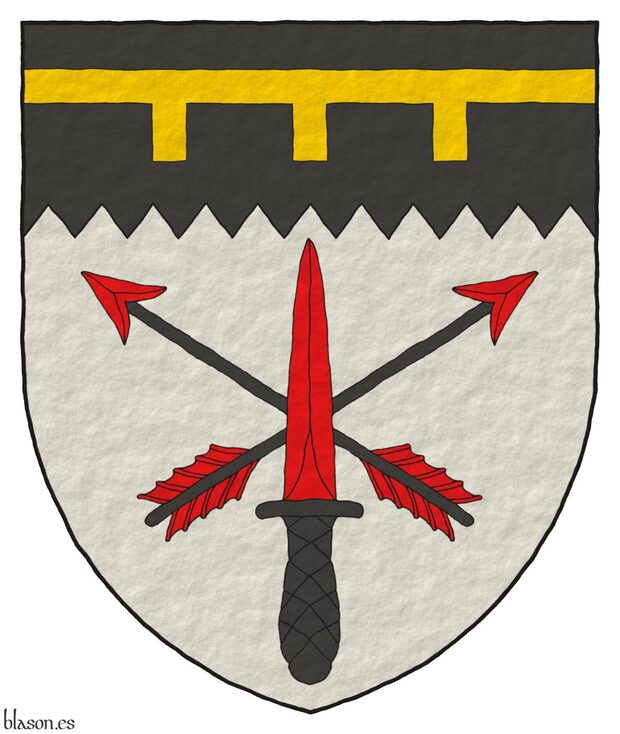
Argent, two arrows points upwards in saltire Sable, barbed and feathered Gules, surmounted of a commando dagger point upwards in pale Gules, hilted and pommelled Sable; on a chief indented Sable, a label of three points Or.
Escudo de plata, dos flechas alzadas en sotuer de sable, barbadas y empenadas de Gules, brochante una daga de comando alzada en palo de gules, guarnecida y pomelada de sable; en un jefe centellado de sable, un lambel de tres pendientes de oro.
Blazon keywords: Argent, Two, Arrow, Point upwards, In saltire, Sable, Barbed, Feathered, Gules, Surmounted, One, Dagger, In pale, Hilted, Pommelled, Chief, Indented, Label of three points and Or.
Style keywords: Pointed, Outlined in sable and Plain tincture.
Classification: Personal, Interpreted and Coat of arms.
Bearer: Power, Guy Harold.


Power, Guy Harold
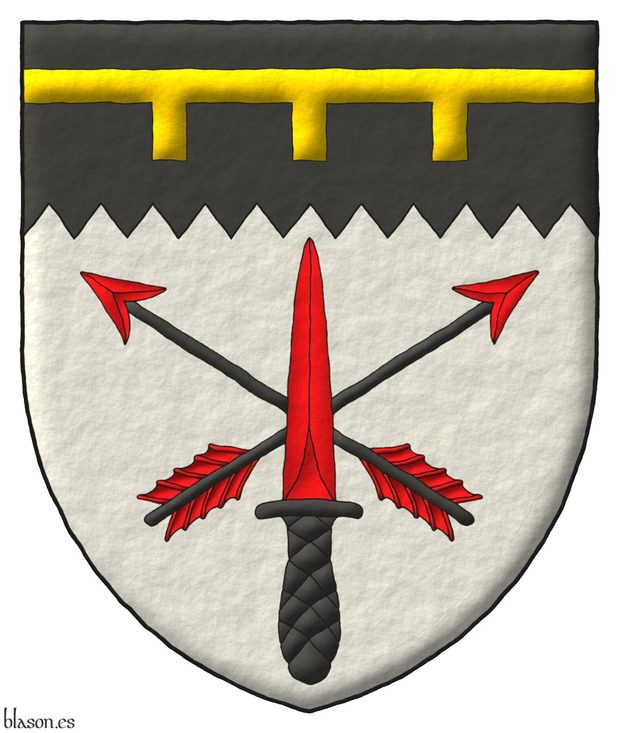
Argent, two arrows points upwards in saltire Sable, barbed and feathered Gules, surmounted of a commando dagger point upwards in pale Gules, hilted and pommelled Sable; on a chief indented Sable, a label of three points Or.
Escudo de plata, dos flechas alzadas en sotuer de sable, barbadas y empenadas de Gules, brochante una daga de comando alzada en palo de gules, guarnecida y pomelada de sable; en un jefe centellado de sable, un lambel de tres pendientes de oro.
Coat of arms emblazoned by me with a pointed shape, illuminated, and with a freehand finishing.
Blazon keywords: Argent, Two, Arrow, Point upwards, In saltire, Sable, Barbed, Feathered, Gules, Surmounted, One, Dagger, In pale, Hilted, Pommelled, Chief, Indented, Label of three points and Or.
Style keywords: Pointed, Outlined in sable, Illuminated and Freehand.
Classification: Personal, Interpreted and Coat of arms.
Bearer: Power, Guy Harold.


Crest and mottos of Guy Harold Power
Argent, two arrows points upwards in saltire Sable, barbed and feathered Gules, surmounted of a commando dagger point upwards in pale Gules, hilted and pommelled Sable; on a chief indented Sable, a label of three points Or. Crest: Upon a helm with a wreath Argent and Sable, a demi-man proper, wearing a beret Vert, grasping in his dexter hand a commando dagger point upwards Or, hilted and pommelled Sable. Mantling: Sable doubled Argent. Motto: «Liberare oppressos». Motto above the crest: «Follow me».
Blazon keywords: Argent, Two, Arrow, Point upwards, In saltire, Sable, Barbed, Feathered, Gules, Surmounted, One, Dagger, In pale, Hilted, Pommelled, Chief, Indented, Label of three points, Or, Crest and mantling, Helm, Mantling, Wreath, Crest, Male figure, Demi, Proper, Beret, Vert, Grasping, Hand, Dexter and Motto.
Style keywords: Pointed, Outlined in sable, Illuminated and Freehand.
Classification: Personal, Interpreted, Coat of arms, Latin language and English language.
Bearer: Power, Guy Harold.


![Ver [Bosque, J. del; 1540] en referencias bibliográficas. Libro abierto, hojas de plata, filo de oro, guardas de gules, tapas de sable.](../css/Libro.Bibliografia.png)
Bosque, J. del; 1540
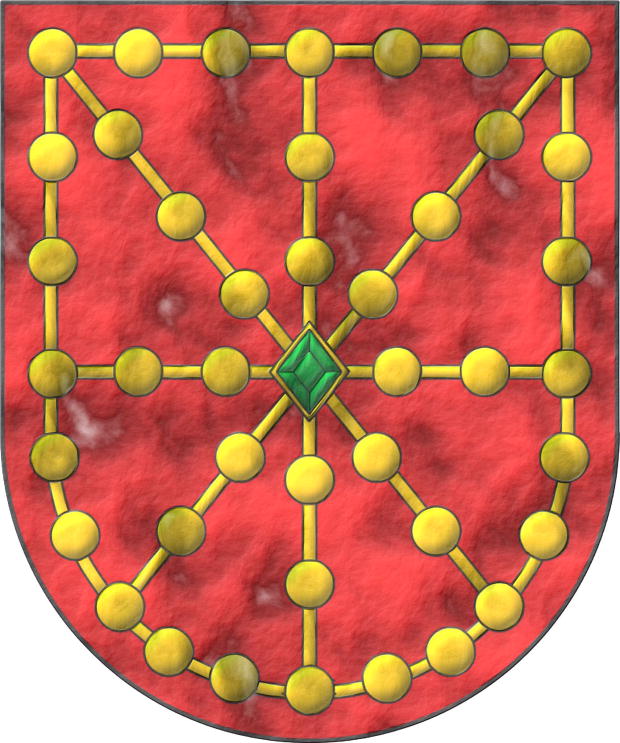
Juan del Bosque, «Libro de Armería del Reino de Navarra», which is currently missing and whose subsequent copy, commissioned in 1572, is kept in the Royal and General Archive of Navarre, estimated year of creation 1540.
The origin of this armorial dates back to 1527, when the Navarrese Courts requested that the Royal Council and the Chamber of Comptos ~ Chamber of Accounts and Fiscal Control, record in a book the coats of arms of the kingdom of Navarre starting with that of the king of Navarre and the houses and lineages of the so-called «ricoshombres», Almorrabides, Guebara, Aybar, Baztanes, Urroz, Lete, Subiça, Rada, Vidaurre, Qasqante, Monteagudo, and Mauleón, also including the coats of arms of other manors, houses, valleys, towns, and nobles [Valverde Ogallar, P. B.; 2001; page 326].
According to [Martinena Ruiz, J. J.; 1982; page 35] the book was compiled around the year 1540, and this is the date I use for referencing this armorial.
This first manuscript created by Juan del Bosque was taken by the royal visitor Hernán Suárez de Toledo, under the pretext of taking it to Emperor Charles V, despite being requested back by the Navarrese Courts, it was never returned and was definitively lost. The armorial that has come down to us is a recreation commissioned in 1572 [Valverde Ogallar, P. B.; 2001; page 327].
According to [Menéndez Pidal de Navascués, F.; 1974; page 19] the recreation of this armorial was carried out based on certifications, such as those from the herald Azcárraga, and notes and partial copies of the stolen book, like the copy kept in the monastery of Leyre.
Another noteworthy bibliographic reference about this armorial, in addition to those previously mentioned, is [Martinena Ruiz, J. J.; Menéndez Pidal de Navascués, F.; 2001].
The image illustrating this bibliographic reference is the coat of arms of the king of Navarre, which I recreated based on the illustration in this armorial, on its first folio according to the numbering given to it in 1613.
Bibliographical reference of century XVI.
The author is Bosque, Juan del.
The following articles cite this bibliographic reference:
- Almorrabides of Navarre
- Aybar of Navarre
- Baztanes of Navarre
- Guebara of Navarre
- Lete of Navarre
- Martinena Ruiz, J. J.; 1982
- Martinena Ruiz, J. J.; Menéndez Pidal de Navascués, F.; 2001
- Mauleón of Navarre
- Menéndez Pidal de Navascués, F.; 1974
- Menéndez Pidal de Navascués, F.; 1985
- Menéndez Pidal de Navascués, F.; Martínez de Aguirre, J.; 2000
- Monteagudo of Navarra
- Navarra, closed carbuncle
- Navarre
- Noblemen of Navarre
- Qasqante of Navarre
- Rada of Navarre
- Subiça of Navarre
- Urroz of Navarre
- Vidaurre of Navarre
-
Language
-
Categories of heraldry
-
Divisions of the field
- Without divisions
- Party per pale
- Party per fess
- Party per bend
- Party per bend sinister
- Tierce
- Tierce sinister
- Tierced per fess
- Tierced per bend
- Tierced pallwise inverted
- Quarterly
- Quarterly per saltire
- Gyronny
- Party per fess, the chief per pale
- Party per pale, the sinister per fess
- Party per fess, the base per pale
- Party per pale, the dexter per fess
- Chapé
- Chaussé
- Party per chevron
- Enté en point
- Flanched
-
Metals
-
Colours
-
Furs
-
Other tinctures
-
Ordinaries and sub-ordinaries
-
Diminutives of the ordinaries
-
Other charges
-
Charges from Nature
Water, Eagle, Bald eagle, Eagle claw, Dorsal fin, Tail fin, Two hands clasped, Lark, Tree, Trunk, Rainbow, Atom, Barbel, Acorn, Bighorn sheep, Arm, Owl, Vulture, Horse, Head, Goat, Camellia, Thistle, Merino ram, Kapok tree, Stag, Doe, Crescent, Increscent, Chrysanthemum, Tail, Tail addorsed, Ermine spot, Hummingbird, Snowflake, Heart, Roe deer, Neck, Roe deers' attires, Raven, Dolphin, Diamond, Tooth, Elephant, Emerald, Starling, Mullet, Mullet of four points, Star of David, Estoile, Male figure, Fleur de lis, Flower, Cornflower, Dogwood flower, Lotus flower, Hop cone, Bluebonnet, Puffin, Ash, Rooster, Claw, Talon, Goose, Heron, Seagull, Pomegranate, Sunflower, Swallow-tail, Falcon, Leaf, Boar, Goldfinch, Laurel, Barn owl, Lion, Lioness, Lion passant, Leopard, Lion rampant guardant, Lynx, Lily, Madonna lily, Flame, Wolf, She-wolf, Parrot, Moon, Hand, Apple, Apple tree, Martlet, Wing, Two wings in vol, Covert, Blackbird, Mount, Trimount, Fly, Wrist, Elm, Olive tree, Orbital, Bear, Palm frond, Palm tree, Dove, Poplar leaf, Panther, Jaguar, Vine, Paw, Forepaw, Foot (palmiped), Foreleg, Peacock, Chest, Pelican, Pelican in her piety, Dog, Brach hound, Warren hound, Fish, Hoof, Beak, Quill, Cinquefoil, Quetzal, Branch, Sprig, Frog, Shamrock, Caboshed, Oak, Holm oak, Rose, Double rose, Savage, Serpent, Plough of Ursa Major, Sun, Sun in splendour, Ray of the sun, Lightning flash, Stem, Badger, Tyger, Linden, Wheat, Wheat spike, Bull, Tulip, Udder, Escallop and Fox.
-
Artificial charges
Halberd, Plough share, Ace of spades, Anchor, Cyclamor, Torch, Bow, Arch, Harp, Non-classic artifact, Winnowing fan, Crozier, Conductor's baton, Pair of scales, Ship, Norman ship, Beret, Grenade, Ecclesiastical cap, Arm vambraced, Knight, Chain, Covered cup, Monstrance, Bell, Bell tower, Cannon dismounted, Carbuncle, Castle, Ribbon, Clarion, Nail, Cord, Dagger, Key ward, Turret, With a turret, Armillary sphere, Sword, Federschwert, Sabre, Parchment, Scroll, Arrow, Club, Garb, Sheaf of tobacco, Scythe, Gauntlet, Axe, Buckle, Galician granary, Polish winged hussar, Church, Oil lamp, Spear, Spear's head, Fleam, Letter, Book, Open book, Closed book, Bookmark, Page, Line, Lantern, Key, Four crescents joined millsailwise, Hammer, Menorah, Mortar, Pestle, Number, Knot, Celtic Trinity knot, Water-bouget, Comb, Piano, Millstone, Millrind, Millwheel, Clay pot, Bridge, Cuffed, Hourglass, Chess rooks, Compass rose, Rosette of acanthus leaves, Mullet of six points pierced, Broken, Portcullis, Wheel, Wagon-wheel, Symbol, Sackbut, Drum, Geometric solid, Tetrahedron, Tower, Trident, Trumpet, Double vajra and Anvil.
-
Immaterial charges
Angel, Archangel, Heart enflamed, Sacred Heart of Jesus, Paschal lamb, Dragon, Wyvern, Phoenix, Garuda, Griffin, Sea-griffin, Winged hand, Our Lady of Mercy, Pegasus, Saint George, Mermaid, Trinity, Triton, Golden fleece, Unicorn and Ouroboros.
-
External elements
-
Heraldic creations
-
References
-
Formats
-
Keywords on this page
Proper, Point upwards, Pointed, Barbed, Bibliography, Beret, Surmounted, Wreath, Carbuncle, Charged, Indented, Crest, Dagger, Outlined in sable, Dexter, Two, Feathered, In the fess point, In pale, In saltire, Coat of arms, Emerald, Male figure, Arrow, Personal, Hilted, Gules, Illuminated, Interpreted, Chief, Label of three points, Mantling, Motto, English language, Latin language, Lozenge, Soft metal, Navarre, Or, Argent, Without divisions, Civic, Pommelled, Power, Guy Harold, Sable, Vert, Shaded, Freehand and One.
